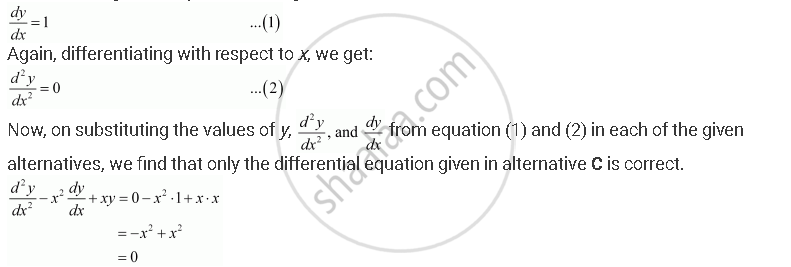Advertisements
Advertisements
प्रश्न
Which of the following differential equation has y = x as one of its particular solution?
A. `(d^2y)/(dx^2) - x^2 (dy)/(dx) + xy = x`
B. `(d^2y)/(dx^2) + x dy/dx + xy = x`
C. `(d^2y)/(dx^2) - x^2 dy/dx + xy = 0`
D. `(d^2y)/(dx^2) + x dy/dx + xy = 0`
उत्तर
The given equation of curve is y = x.
Differentiating with respect to x, we get:

Hence, the correct answer is C.
APPEARS IN
संबंधित प्रश्न
Form the differential equation of the family of parabolas having vertex at origin and axis along positive y-axis.
Form the differential equation of the family of ellipses having foci on y-axis and centre at origin.
Form the differential equation of the family of hyperbolas having foci on x-axis and centre at origin.
Form the differential equation of the family of circles in the first quadrant which touch the coordinate axes.
For the curve y = 5x – 2x3, if x increases at the rate of 2 units/sec, then find the rate of change of the slope of the curve when x = 3
Show that the family of curves for which `dy/dx = (x^2+y^2)/(2x^2)` is given by x2 - y2 = cx
Form the differential equation from the following primitive where constants are arbitrary:
xy = a2
Form the differential equation from the following primitive where constants are arbitrary:
y = ax2 + bx + c
Form the differential equation corresponding to (x − a)2 + (y − b)2 = r2 by eliminating a and b.
Form the differential equation of the family of curves represented by the equation (a being the parameter):
(2x + a)2 + y2 = a2
Form the differential equation of the family of curves represented by the equation (a being the parameter):
(x − a)2 + 2y2 = a2
Represent the following families of curves by forming the corresponding differential equations (a, b being parameters):
x2 − y2 = a2
Represent the following families of curves by forming the corresponding differential equations (a, b being parameters):
x2 + (y − b)2 = 1
Represent the following families of curves by forming the corresponding differential equations (a, b being parameters):
(x − a)2 − y2 = 1
Form the differential equation of the family of circles in the second quadrant and touching the coordinate axes.
Find one-parameter families of solution curves of the following differential equation:-
\[\frac{dy}{dx} + 3y = e^{mx}\], m is a given real number.
Find one-parameter families of solution curves of the following differential equation:-
\[x\frac{dy}{dx} - y = \left( x + 1 \right) e^{- x}\]
Find one-parameter families of solution curves of the following differential equation:-
\[x\frac{dy}{dx} + y = x^4\]
Find one-parameter families of solution curves of the following differential equation:-
\[\left( x + y \right)\frac{dy}{dx} = 1\]
Find one-parameter families of solution curves of the following differential equation:-
\[e^{- y} \sec^2 y dy = dx + x dy\]
Write the order of the differential equation representing the family of curves y = ax + a3.
The differential equation which represents the family of curves y = eCx is
Form the differential equation representing the family of curves y = mx, where m is an arbitrary constant.
Form the differential equation of the family of ellipses having foci on y-axis and centre at the origin.
Find the differential equation of the family of curves y = Ae2x + B.e–2x.
The differential equation representing the family of curves y = A sinx + B cosx is ______.
Find the equation of a curve passing through (2, 1) if the slope of the tangent to the curve at any point (x, y) is `(x^2 + y^2)/(2xy)`.
Find the equation of the curve through the point (1, 0) if the slope of the tangent to the curve at any point (x, y) is `(y - 1)/(x^2 + x)`
The differential equation `y ("d"y)/("d"x) + "c"` represents: ______.
The differential equation of the family of curves x2 + y2 – 2ay = 0, where a is arbitrary constant, is ______.
The curve for which the slope of the tangent at any point is equal to the ratio of the abcissa to the ordinate of the point is ______.
The differential equation representing the family of circles x2 + (y – a)2 = a2 will be of order two.
Find the equation of the curve at every point of which the tangent line has a slope of 2x:
From the differential equation of the family of circles touching the y-axis at origin
Form the differential equation of family of circles having centre on y-axis and raduis 3 units
Form the differential equation of the family of hyperbola having foci on x-axis and centre at origin.
